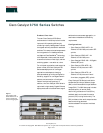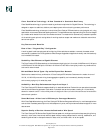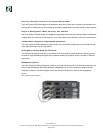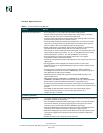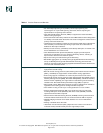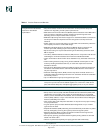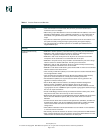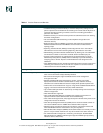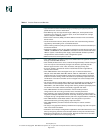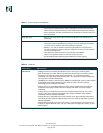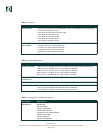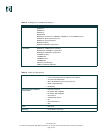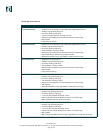
Cisco Systems, Inc.
All contents are Copyright © 1992–2003 Cisco Systems, Inc. All rights reserved. Important Notices and Privacy Statement.
Page 8 of 18
• Trusted boundary provides the ability to trust the QoS priority settings if an IP
phone is present and to disable the trust setting in the event that the IP phone is
removed, thereby preventing a malicious user from overriding prioritization
policies in the network.
• Multilevel security on console access prevents unauthorized users from altering
the switch configuration.
• The user-selectable address-learning mode simplifies configuration and
enhances security.
• Bridge Protocol Data Unit (BPDU) guard shuts down Spanning-Tree Protocol
PortFast-enabled interfaces when BPDUs are received to avoid accidental
topology loops.
• Spanning Tree Root Guard (STRG) prevents edge devices not in the network
administrator’s control from becoming Spanning Tree Protocol root nodes.
• IGMP filtering provides multicast authentication by filtering out non-subscribers
and limits the number of concurrent multicast streams available per port.
• Dynamic VLAN assignment is supported through implementation of VLAN
Membership Policy Server (VMPS) client functionality to provide flexibility in
assigning ports to VLANs. Dynamic VLAN enables the fast assignment of IP
addresses.
• Cisco CMS Softwaresecurity wizards ease the deployment ofsecurity features for
restricting user access to a server as well as to a portion or all of the network.
• 1000 access control entries (ACEs) are supported.
Manageability
Superior manageability • Cisco IOS CLI support provides common user interface and command set with all
Cisco routers and Cisco Catalyst desktop switches.
• Service Assurance Agent support facilitates service-level management
throughout the LAN.
• Switching Database Manager templates for access, routing, and VLAN
deployment scenarios allow the administrator to easily maximize memory
allocation to the desired features based on deployment-specific requirements.
• VLAN trunks can be created from any port, using either standards-based 802.1Q
tagging or the Cisco Inter-Switch Link (ISL) VLAN architecture.
• Up to 1024 VLANs per switch or stack and up to 128 spanning-tree instances per
switch are supported.
• 4000 VLAN IDs are supported.
• Voice VLAN simplifies telephony installations by keeping voice traffic on a
separate VLAN for easier administration and troubleshooting.
• Cisco VLAN Trunking Protocol (VTP) supports dynamic VLANs and dynamic trunk
configuration across all switches.
• Cisco Group Management Protocol (CGMP) server functions enable a switch to
serve as the CGMP router for CGMP client switches. EMI is required.
• IGMP snooping provides fast client joins and leaves of multicast streams and
limits bandwidth-intensive video traffic to only the requestors.
• Remote Switch Port Analyzer (RSPAN) allows administrators to remotely monitor
ports in a Layer 2 switch network from any other switch in the same network.
• For enhanced traffic management, monitoring, and analysis, the Embedded
Remote Monitoring (RMON) software agent supports 4 RMON groups (history,
statistics, alarms, and events).
Table 1 Product Features and Benefits
Feature Benefit



